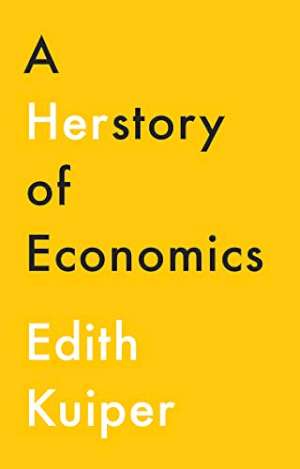24 November 2022
A Herstory of Economics
Edith Kuiper
2022, Polity Press, 256 pages,
ISBN 9781509-538447
Reviewer: Vicky Pryce

As the title suggests this is a book about the women economists who influenced economic thinking and yet generally go unnoticed. It is not so much about modern women economists who have progressed the subject in universities and in policy but more about women in earlier centuries, mainly in US and in Britain and in its colonies starting with 18th century writers who made significant contributions to the thinking about women and work and who have at times been pioneers in pushing for, and achieving change.
As the world industrialised and globalised, women became increasingly marginalised as economic agents, their contributions undervalued and underpaid – in fact, very often not paid at all. It has taken hundreds of years of progress to change that – and we still have some way to go.
This is a most enlightening book and frankly an eye-opener about the richness of economic writing by such an amazing array of women. In the early days the preoccupation was with women’s work at home, the original ‘oikonomia’ from the Greek word ‘oikos’, meaning home. One book in the references is by a Mrs Smith published in London in 1810 with the title: The Female Economist; or, A Plain System of Cookery: For the Use of Families’. That sounds worthy if old- fashioned but the title obscures, one guesses, the rough life of many women at the time. Nearly a century earlier Mary Collier, a working class writer, in her 1739 ‘The Woman’s Labour ‘, portrayed the plight of women who had to toil all day and then rush to look after their home and family, produce a meal and make their man, returning from work, comfortable at home. And even though attitudes were changing and progress was being made over the three subsequent centuries, women continued getting a raw deal while having to cope with misogynistic attitudes to the value of their work by male economic writers and theoreticians – and, frankly, by society as a whole. Combining work and family was not easy in any case and women economic writers were beginning to increasingly focus on the economic plight of women who, as economic models were changing, found that their employment opportunities were limited and they were often unable to maintain themselves.
But the need to change the women’s lot was gathering pace as far as the preoccupation of women writers was concerned. A South African novelist called Olive Schneirer wrote in ‘Women and Labour’, published in 1911, that women needed to be helped to become economically independent for the benefit of all, including their children and society more generally – a strong long-term cost benefit calculation if ever there was one. But it took until the late 19th- early 20th century before movements became better organised. Barbara Hutchins in ‘The Working Life of Women’ outlined the implications of the move of women from a pre-capitalist society to a capitalist one. But the inability of women to maintain themselves and the poverty many of them had to endure were main reasons behind the setting up of the Langham Group in London supported by economic writers such as Barbara Leigh Smith Bodichon and Bessie Rayner Parks, and the Fawcett Women’s Group (FWG) and the Society for Promoting the Employment of Women founded by Jennie Boucherett.
But it would be wrong to conclude that women writers’ contribution through the centuries only focussed on women, even though their contribution to bringing about change could be argued to have been material. One example given by Edith Kuiper is of Ida Minerva Tarbell , an American journalist who despite spending many of her later writings on the women’s question, also wrote ‘The History of the Standard Oil Company’ which was published in 1904 and which showed the dark side of the Rockefeller oil company and contributed thus to the eventual suing of Standard Oil and the breaking up of Standard Oil into a number of smaller companies in 1911.
